
Revenge of the Forest
Shek Yerand, or "Blond Fury" - this is what residents of Vanadzor who live right outside the forest call the sliding mud that flows down the hill. On Vanadzor's Khndzorut Street, people say that the spring floods have become an annual problem. The hill starts "running away" and the silt and stumps that it moves with it fill people's houses. Jivan Israelyan's two-floor house is located right below the forest. Only a few pieces remain of the wooden fence that once surrounded the house. Stumps and fragments of wood brought down by the mudslides have ended up in his yard and vegetable garden, and silt has flooded the cellar and boiler. "The tragedy started at night. My children haven't gone to class for a week; they've been frightened. It wasn't even possible to walk down the street," said 43-year old Jivan. There was a layer of silt in his yard 70 centimeters deep; it took two trucks to haul it away.
Eight years ago, Jivan managed to get hold of a seven-meter pipe and connect it to the rainwater pipe, so that the rainwater circumvented the house and flowed into the river. The dirt from the mudslides has clogged that pipe. "The only thing I ask of the authorities is that they come and unclog the pipe, so that water flows through the underground connection into the river," said Jivan.
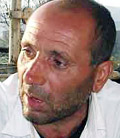 |
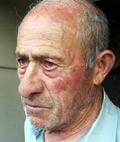 |
| Jivan | Hrachyik Mkhitaryan |
Another Khndzorut resident, 77-year old Hrachyik Mkhitaryan, was worried that one of these days the landslide would come and wipe away everything with it. "If you'd climb up and see the cracks in the houses, you'd say 'Leave. You're making a mistake living here,'" the old man complained.
Two years ago, they neighborhood lived through a similar calamity. Hrachik Mkhitaryan told us how the muddy water had reached his garage, flooded his vegetable garden and ruined his planted potatoes. "It's even scarier now. During Soviet times, there used to be a forest here that covered a lot of territory. It's open land now, and the water comes in from all sides, filling our houses," said the long-time resident, as recalled landslides past and present.
The silt passed through Khndzorut Street and reached the Yerevan Highway. Though Vanadzor City Hall managed to clean up the silt and sand on the highway, transport on the Vanadzor-Dilijan road was disrupted for several days. "The problem is that the whole region could collapse if the water were to constantly flow into the soil. If this happens it is very likely that the whole hill will slide into the river and take the houses with it," said Lyova Karapetyan, Head of Communal Services and Improvement at Vanadzor City Hall.
Tigran Papanyan, head of the Construction and Engineering Department at City Hall, sees deforestation as the underlying cause of the problem. "It wasn't enough that they cut the trees down; now they're removing the stumps as well, without understanding that they're causing damage to their own homes that way."
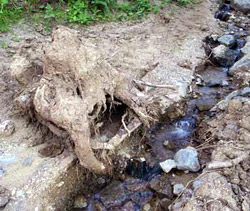 |
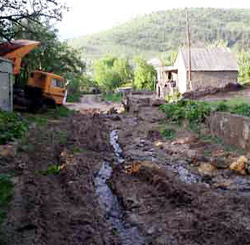 |
The mudslides in Khndzorut damaged the Tsovasar water pipe, which supplies drinking water to 45,000 people in Vanadzor. Samvel Ghazaryan, vice president for Utilities at the water company, said that they had cut off the supply twice in May to repair the pipe. On the first occasion, they replaced a 35-meter segment of the pipe; the second time they were forced to relocate the pipe away from the landslide zone.
Geologist Artak Demirchyan also characterized what is happening every year in Khndzorut as landslides primarily caused by deforestation. "Our hillsides are at quite a steep angle, and the soil is kept in place by forests." Deforestation was followed by a rotting of the root system of the stumps. The roots slowly turned to soil and facilitated the landslides that occurred.
There are a number of ways to protect against landslides, such as reforestation, and building barriers or diversions. Norik Babayan, head of the Lori Marz Provincial Rescue Department considered the most suitable solution to be building diversions in the Khndzorut area and other parts of town which had similar problems.
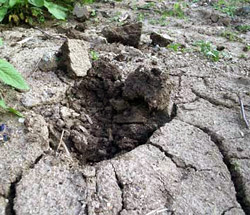 |
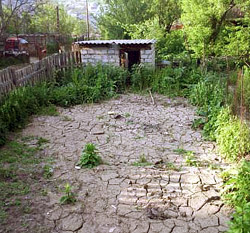 |
A network of trenches would help the muddy water flow away, rather than accumulate in one area. But Vanadzor's municipal government views that work as beyond their means.
"This is a matter of state care; it requires major financing," said Artak Demirchyan, a staff member at the Department of Ecology and Agriculture of the Lori Marz.
"The soil must be studied; we must determine if there is a lot of water in the soil and whether or not there is the possibility of mudslides," explained Lyova Karapetyan, head of Vanadzor's Department of Communal Services and Improvement.
"Losses could be even greater in the future. Besides material damage, lives could be lost as well," said Artak Demirchyan, who is a geological expert at the Lori Governor's Office, recalling some of the natural disasters that occurred in Lori during Soviet times. The Azeri village of Upper Kilisa had been buried by a landslide at one point, he said, and only a few people had survived.
"If there is no forest, there is nothing to preserve humidity. Natural precipitation evaporates very quickly. The precipitation that does not evaporate should be absorbed by the black soil. Instead, it flows rapidly into the Debed River basin. Along with the surface water, which is also no longer absorbed by the non-existent forest, this leads to landslides," Artak Demirchyan explained.
Experts have proven that the number of landslides in Lori is increasing every year. Three years ago, the melting snow and flowing water led to landslides in a number of communities - bridges collapsed and rivers overflowed.
The Lori Government admitted that around thirty percent of their 98,000-hectare forest had been cut down over the past 18 years, an irreversible loss. Fifteen percent had been removed completely, and the rest now faces total destruction. Of the 5,000 hectares of forest in Vanadzor, around 1,500 had been cut down over the past few years. "It would take 40-50 years to reestablish this forest," thought Artak Demirchyan.
Ecologists explain that the so-called secondary forest - one which replaces a deforested area - does not have the same significance as the original, because "the valuable trees have no offshoots and die, while the other ones have offshoots and people then cut them down to use the land for cultivation." This raises the risk of landslides every year.
"Not even planting trees will help the situation," said biologist Zaruhi Vardanyan. Artak Demirchyan added that so far, reforestation campaigns had not been professionally planned and were therefore less effective. "It's not just that such climatic phenomena have increased, but human activity, often artificial in nature, has also damaged the ecological balance."
According to Demirchyan, 500-600 natural springs and brooks in Lori have dried up due to deforestation.
"After all, all parts of nature are intricately linked to each other - if you damage one, you ruin the whole system," he said, acknowledging that that we seem to be on the road to desertification.
 Videos
Videos Photos
Photos
Write a comment